The post that Matt Reverzani gave us about his work with a Praktica L prompted me to write an article about this range of cameras. Now the Prakticas were always ‘bottom of the pile’ of serious single lens reflexes but so many of us started with these cameras and moved onto other marques leaving behind a set of equipment that can still perform well.
The resurgence of film photography has been encouraging for those of us who never stopped! While I have digital cameras for my main work I always have film cameras loaded, all of them from my collection of many makes.
However, this resurgence has caused an increase in both the price of film and the price of cameras and lenses and the Prakticas continue to give us a low cost way into film photography if you choose carefully. I will concentrate on the M42 range of cameras rather than the later ‘B’ series.
I live in the UK, so my experiences are based in this country. Like many people I started my photography with a Praktica (in 1965!). I’ve never lost my regard for them; they are versatile, and some are long-lived. The mount also lets you choose some good lenses. I think these cameras were popular in the USA in the late 1970s, but the biggest market was Western Europe.
I’ll summarise the history of the brand and manufacturer and then tell you which of the models I’ve found to be most reliable. I’ll also outline the better lenses although you do have so many options as millions of M42 mounts were made.
Now between 1949 and 1990 8.5 million Praktica cameras were made in Dresden so the history is long and involved.
History of Praktica.
Firstly, the M42 lens mount; it is often known as the ‘Pentax thread’ but that’s a misnomer. The M42 mount was first introduced by Zeiss Ikon on the Contax S. Zeiss Ikon and its constituents were based largely in Dresden and, as we know, that city was devastated by Allied bombing in WWII. After the separation of Germany into West and East following the war, Dresden was deep inside East Germany but a lot of Zeiss Ikon staff moved to the West before the border was shut. The Dresden-based company revitalised manufacture but it was losing the legal battle to use the Zeiss Ikon name and eventually adopted Pentacon as the manufacturer’s name. The higher priced lenses were labelled as manufactured by Carl Zeiss Jena. This disappeared eventually to be replaced by ‘Pentacon’.
The Praktica cameras were developed first in 1939 with the Praktiflex produced by Alois Hoheisel and then the first post-war Praktica was built in 1949 by the Company “Mechanik Kamera Werkstätten VEB Niedersedlitz” (KW) in Dresden. The Praktiflex laid out its controls in a way that became the standard for film SLRs. These are old cameras and may not have the M42 mount so I wouldn’t recommend them for frequent use. Kamera-Werke Dresden-Niedersedlitz (KW) developed the camera into robust and versatile products up to and including the Praktica IV and V. The cameras were also a valuable export as they were sold easily in Western Europe. The firm stopped producing the SLR cameras after German reunification.
Which Praktica to Buy?
There are three ‘series’ of M42 mount Prakticas:
- The first series dating from between 1949 and 1952 up to about 1965
- The ‘Nova’ series dating from 1965 to about 1970
- The ‘L’ series dating from 1970 to 1990
The First Series – 1952 to 1965
These cameras had a shutter speed ranging from 1/500 to 1/2 seconds set on a ‘lift and twist’ shutter speed ring with a top ring to select slower speeds. Apart from the Praktica V there is no instant return mirror and the back is removed to load a film. The models I’ve found to be the most reliable are described briefly below:
Models
FX2 and FX3 – had semi-automatic and automatic lens operation, an accessory pentaprism that fitted above the waist level finder and knob wind.
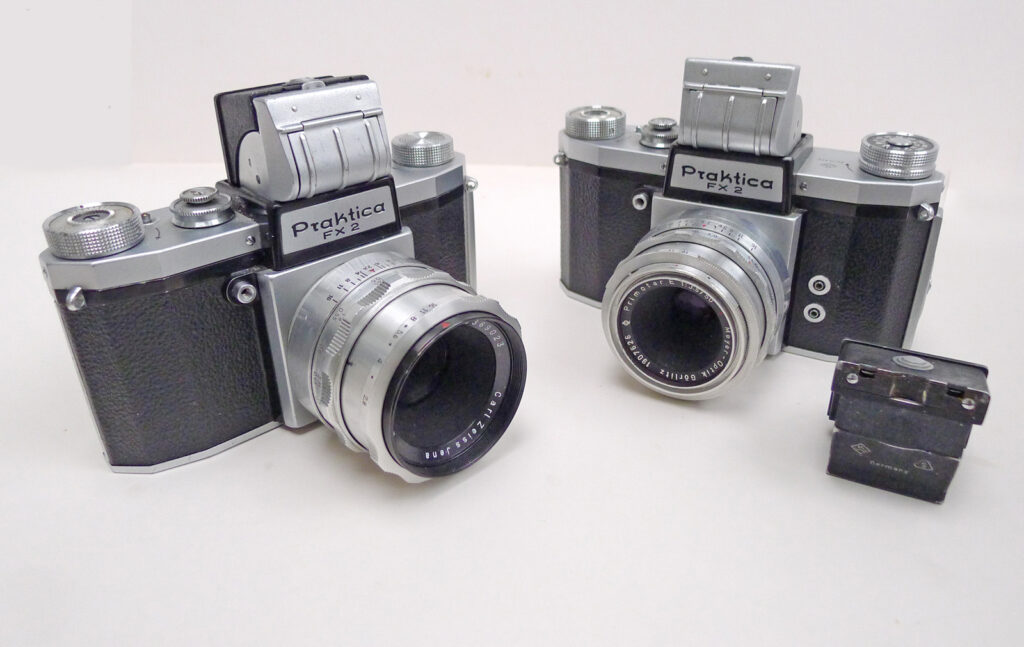
Praktica IV and V (Photograph 2) — the Praktica IV (1959): this used the same shutter and body as the FX cameras with a permanently fixed pentaprism. It also has a knob wind on the top plate and lever wind underneath. If the camera has its original standard lens this may be pre-set or automatic (I’ll describe lenses later). The Praktica V included an instant return mirror with a ‘shutter uncocked’ indicator in the viewfinder. The shutter speeds are in geometric sequence, but it is missing the 1/15 sec.
In-built Metering — There were versions of the models IV and V with built-in, uncoupled selenium cell meters, these models had a ‘B’ after the model name. This nomenclature also applies to later series of cameras. The Praktica IV and V are better built than the later Nova series and I find them good cameras to use even though they are 60 plus years old. The shutters are generally reliable but check the model is working at slower speeds and isn’t capping. You can use these cameras today to good effect, but it will slow you down.
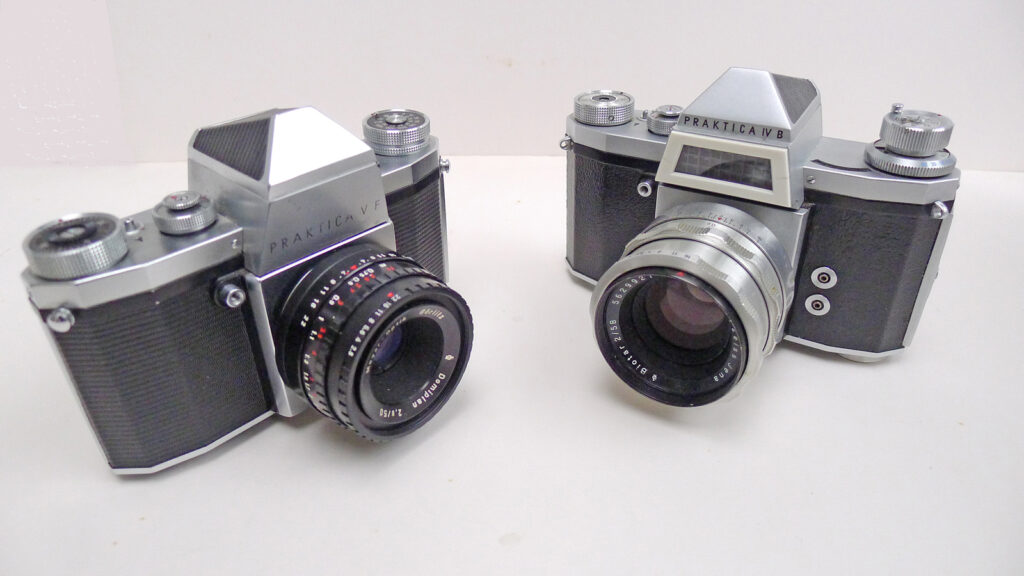
Praktica Nova and Nova 1 – Prakticamat
The range was then ‘developed’ into the Praktica Nova in 1965, it had the lever wind on top and an angled shutter release button. You can identify these by the black and chrome stripes on the pentaprism.I have not found these are anywhere near as reliable as the earlier IV/V series, with one exception.
This was the Prakticamat introduced in 1965. It was the first European SLR with TTL metering. This camera has the style of the Nova but has its name on the front and the shutter speed dial is round the rewind crank. The metering on the Prakticamat often doesn’t work but the shutter is usually in good order. See Photograph 3
The Praktica Super TL also had TTL metering. I have owned several and all the shutters failed.
By now the manufacturing companies were combined into ‘Pentacon’, I believe this name derives from the words ‘pentaprism’ and ‘Contax’
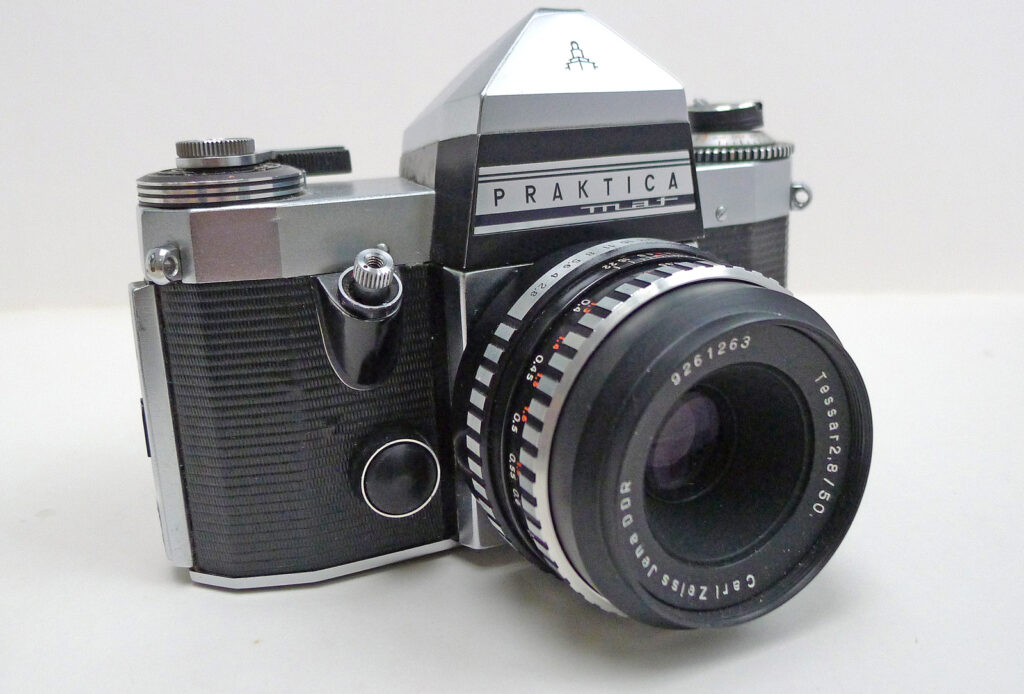
The L Series
Introduced in 1970 these looked more like Japanese SLRs and had a vertically running focal plane shutter speeded from 1/1000 to 1 second. This is made of ‘Lamina’ steel (hence the ‘L’ nomenclature). These shutters have so far proved to be very reliable if a little noisy.
The first models were:
- The ‘L’ It had no meter or delayed action.
- The LB was equipped with a non-coupled, selenium cell meter.
- The LTL had stopped down TTL metering and delayed action
- The LLC had full aperture TTL metering using electrical connections between lens and body
- The VLC was an LLC with interchangeable viewfinders
Now this series of cameras was developed over time, the LTL became the MTL series, ending with the MTL50 that had LED metering indicators. The LLC became the PLC2 and PLC3. The VLC became the VLC2 and VLC3.
(Photographs 4 and 5 show an MTL3 and a VLC and an MTL50 and PLC3)
The full aperture metering bodies used a V21 4.5 battery type that is tricky to obtain, but you can get adaptors that let you use three 1.5-volt SR44 or LR44 batteries.
The LLC/PLCs work well with ‘electric’ lenses, but for other lenses using it in ‘stopped down mode’ can be irksome
To provide maximum compatibility with Pentacon and other makes of lenses, I prefer the stopped down metering LTL / MTL series.
If you decide to try one of these, remember it is not a Leicaflex, there is a solid thump as it fires. I do not find it causes any camera shake.
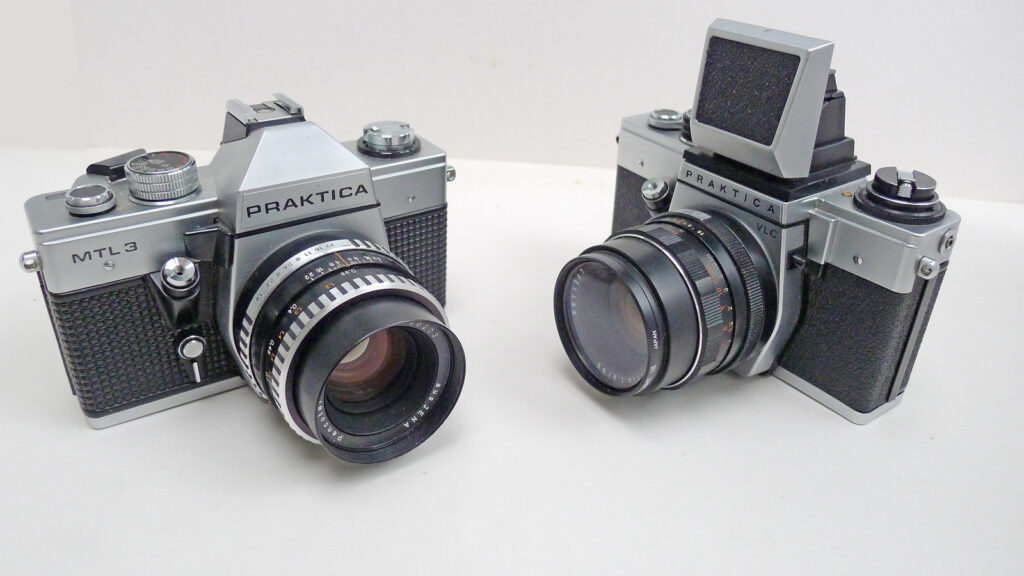
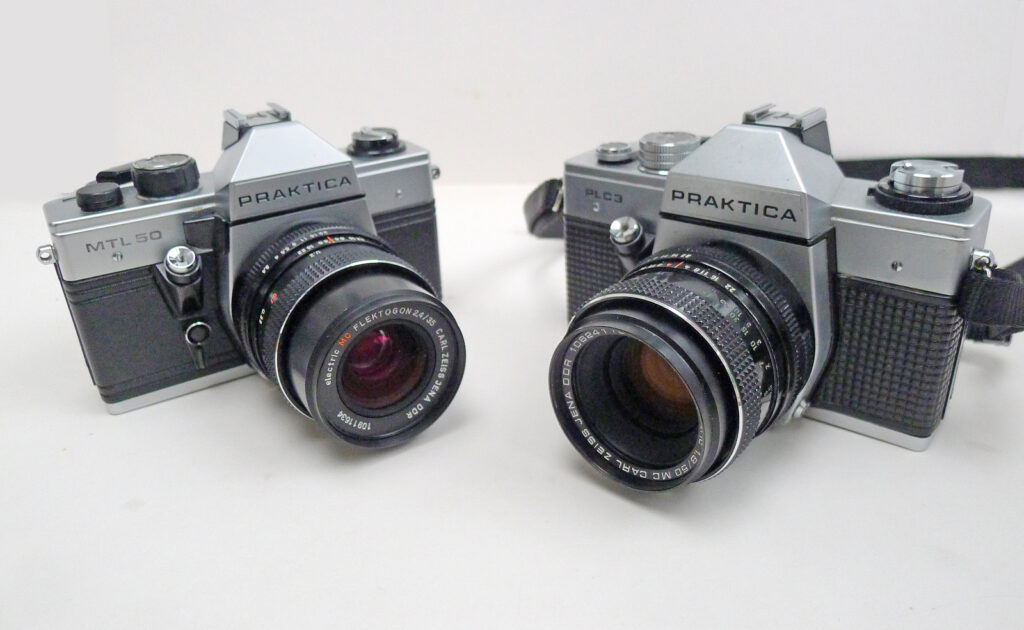
My Praktica Collection
You will see in the following image that I have a considerable collection of these cameras. Despite the fact that some of them look a bit haphazardly placed they are all working cameras.
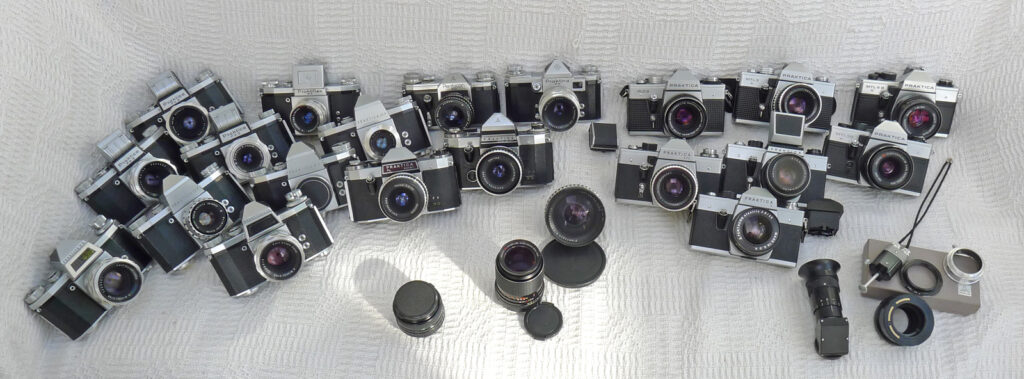
If you want to go through this lot then start on the left hand side. On the top row, the third camera along is an original Praktiflex. To its left you will see a number of FX2 and FX3 models with the chrome lenses, some have the auxiliary pentaprism attached. If front of these are a number of Praktica IVs and Vs with a range of standard lenses. These make up some of the first series from 1952 to 1965 as described above.
To the right of the Praktiflex on the back row are two important cameras. The first is a Pentacon FM, this was similar to the original Zeisss Ikon Contax S that introduced the M42 mount. To the right of the Pentacon is a Praktina FX. This camera was built by the same manufacturer as the Prakticas but had a breech lock bayonet mount, interchangeable viewfinders, a direct vistion finder, even a clockwork motor wind. It was produced alongside the Prakticas during the 1950s but in far fewer numbers before being phased out.
If you move down, in front of the Pentacon and Praktina you will see a Nova 1 and a Prakticamat. The Prakticamat was my workhorse for about 8 years and the shutter is still good.
On the right hand side you will see seven of the L series. These look more like Japanese SLRs. There is a basic L at the front, a VLC with interchangeable waist level finder, an LTL with TTL metering and behind them is a full aperture meter reading PLC 3 and few of the MTLs. The MTL50 has the 35mm Flektogon. These all work although the meter in the VLC has failed.
In the middle you will see a 20mm f4 Flektogon and a 135 f3.5 aus Jena. I find these good lenses. The one with the lens cap on is the 28mm Pentacon, this isn’t such a good performer. On the right hand side are some accessories such as the double cable release and the accompanying Z ring that keep auto lenses working on bellows.
Lenses
I’ll try to provide a guide to the standard lenses.
The First Series – lenses ranges in ‘quality’ and price:
- The 50mm f/2.9 Meritar 3 element lens – variable in quality
- Various Meyer Optik lenses, usually Primotars with maximum apertures of f/3.5 or f/2.8. – Preset and Automatic diaphragms – I like the rendering of these, some photographers don’t!
- Carl Zeiss lenses. The 50mm f2.8 Tessar and the more expensive 58mm f2 Biotar. The Biotar can be expensive.
Lenses with aluminium bodies can have pre-set or semi-automatic diaphragms. You will have to turn the front ring to open the lens to maximum aperture for viewing. It will close as you press the shutter but will not open again until you turn the ring once more. There was an f1.9 Meyer Optik Primoplan, but I have no experience of this. There are good examples of the Carl Zeiss 50mm f/2.8 Tessars and 58mm f/2.0 Biotars in this series but many are cloudy with stiff focussing. They can be serviced but bear the cost in mind.
The ‘Nova’ Series were usually coupled with one of the following
- A 3 element, preset Meritar in an updated body
- A 3 element Meyer Optik automatic f2.8 Domiplan
- A Carl Zeiss f2.8 Tessar
- A Meyer Optik Oreston f/1.8
- A Carl Zeiss f/2.0 Pancolor.
These came with various finishes, the commonest being the black and white ‘zebra’ finish. The Domiplan is often criticised as having low contrast and resolution but I’ve had good results from a couple, and these are often mechanically in better condition than the Tessars. The focusing mounts on the Tessars can be very stiff and the apertures might not operate. The Meyer Optik Oreston gives images almost the same as the much more expensive Zeiss Pancolar. The Pancolors are mechanically better, but these are much pricier. The results are excellent with wonderful bokeh.
Note – occasionally, one will be coupled to a body being sold ‘for parts’ at a cheap price, so it’s worth watching the likes of eBay.
The Oreston was developed into the Pentacon “Auto” 50mm f/1.8 but look for one of the first generation of the ‘L’ series. It is NOT the same as the Pentacon “Auto Multi Coated” 50mm f/1.8 which is more recent and is reportedly not as sharp across the aperture range. Pentacon took over Meyer Optik lens production, and the lenses gradually declined in quality as they redesigned and re-coated them. The ‘L’ series came with the same lenses in black mounts that can suffer the same mechanical issues.
Other East German focal lengths
- The f/2.4 35mm Flektogon, in its various forms, performs well and focuses so closely that you can make creative close-ups.
- The 20mm f4 Flektogon, this also comes in a f/2.8 version, they are big lenses, but they perform impressively. They are increasing in price
- The 29mm Pentacon is not so good, and I prefer:-
- The Meyer Optik 30mm f/3.5 Lydith preset lens.
- The Carl Zeiss Sonnar f3.5 135mm is top of the telephoto lens bargains, it performs impressively and focusses to 3.5 feet (1.07 m).
- The 100mm f2.8 Meyer Optik Trioplan that sells for silly money, the preset Orestor is nearly as good but again prices are creeping up.
Other Makes of Lenses
The M42 mount was so popular that millions of lenses are available.
My favourites that can still be bought at reasonable prices are the Asahi Pentax SMC lenses. I like the 50mm f1.4 and the rare 120mm f2.8
I use the Schneider M42 lenses that were built for the Edixas, the 50mm Xenar is good. They work perfectly.
Using The Lenses With Digital Cameras.
There are adaptors abounding on the Web to fit these M42 lenses to just about all mirrorless cameras. If you want to use the lenses with your Leica M240s to M11s then you can easily do so.
Example Photographs
The accompanying photographs show the results and their titles tell you which camera and lens was used:
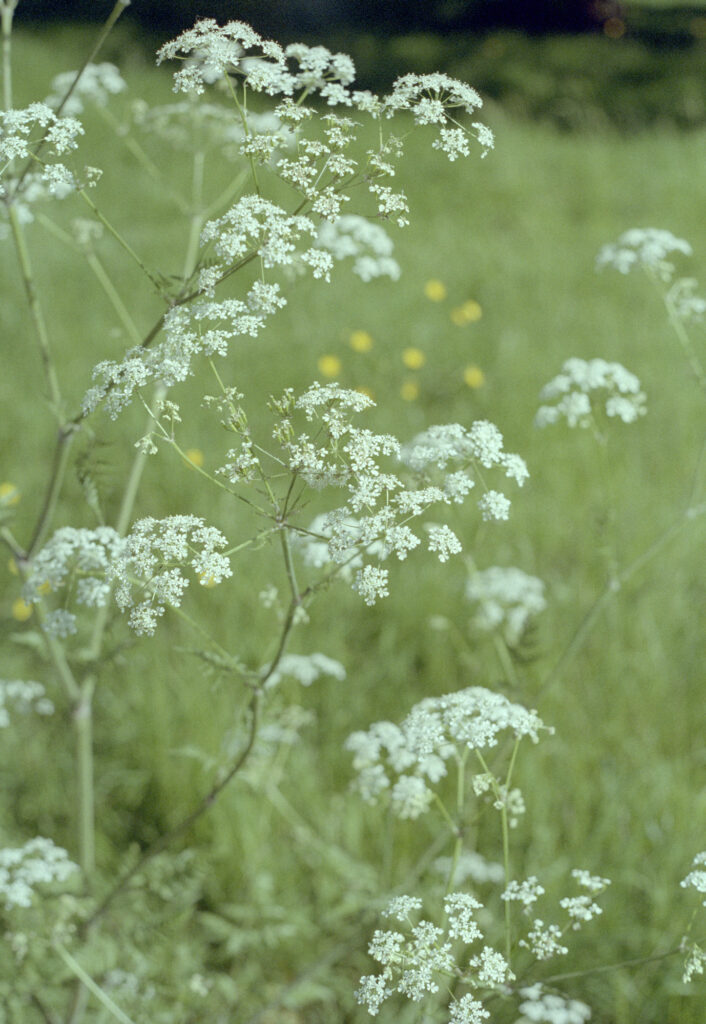
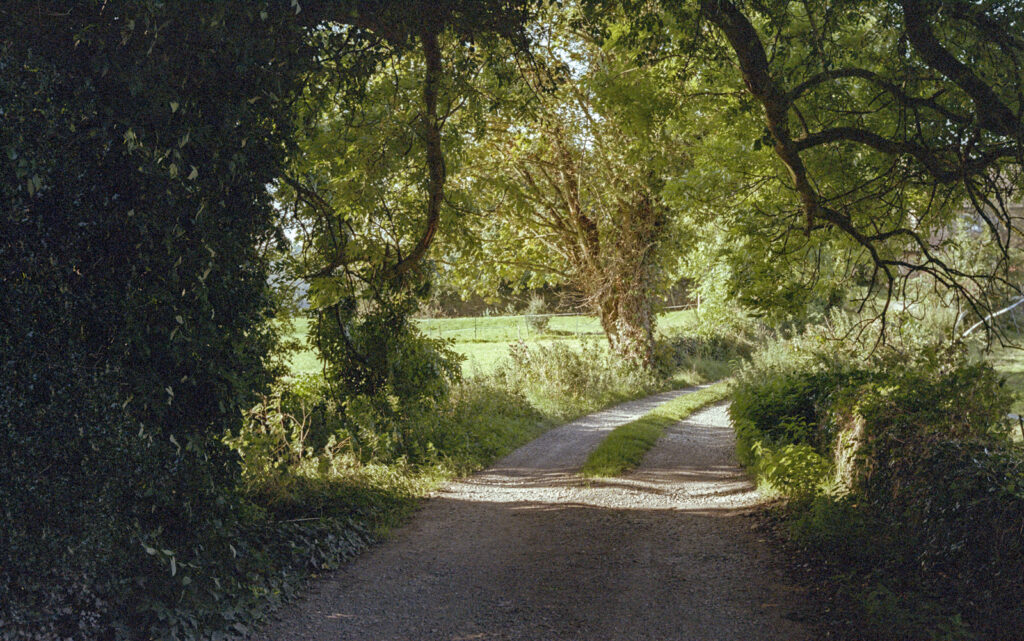
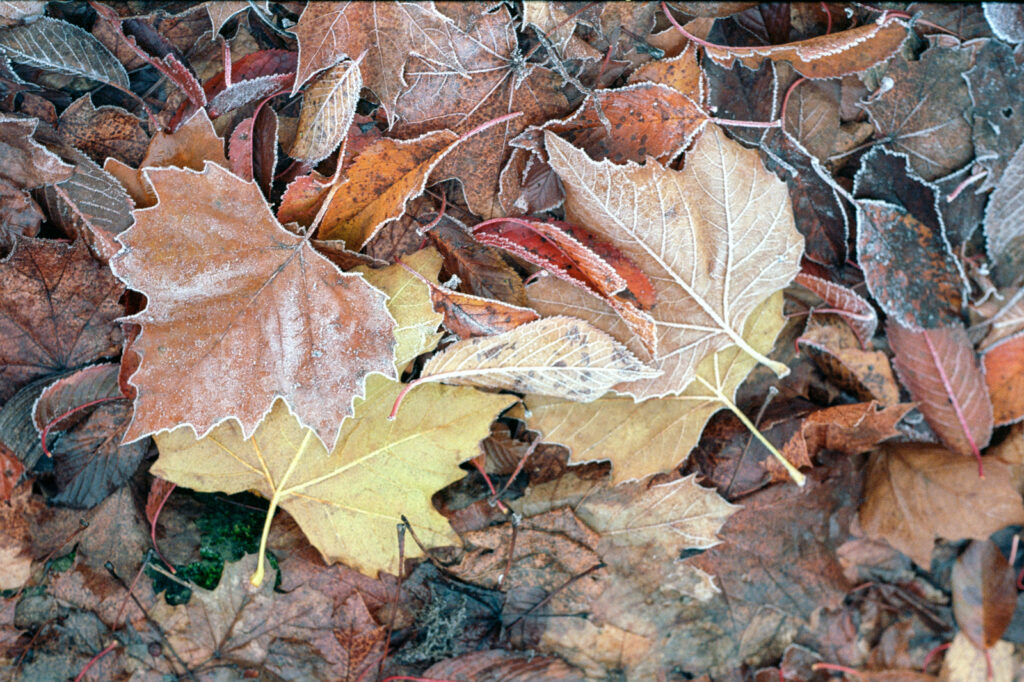
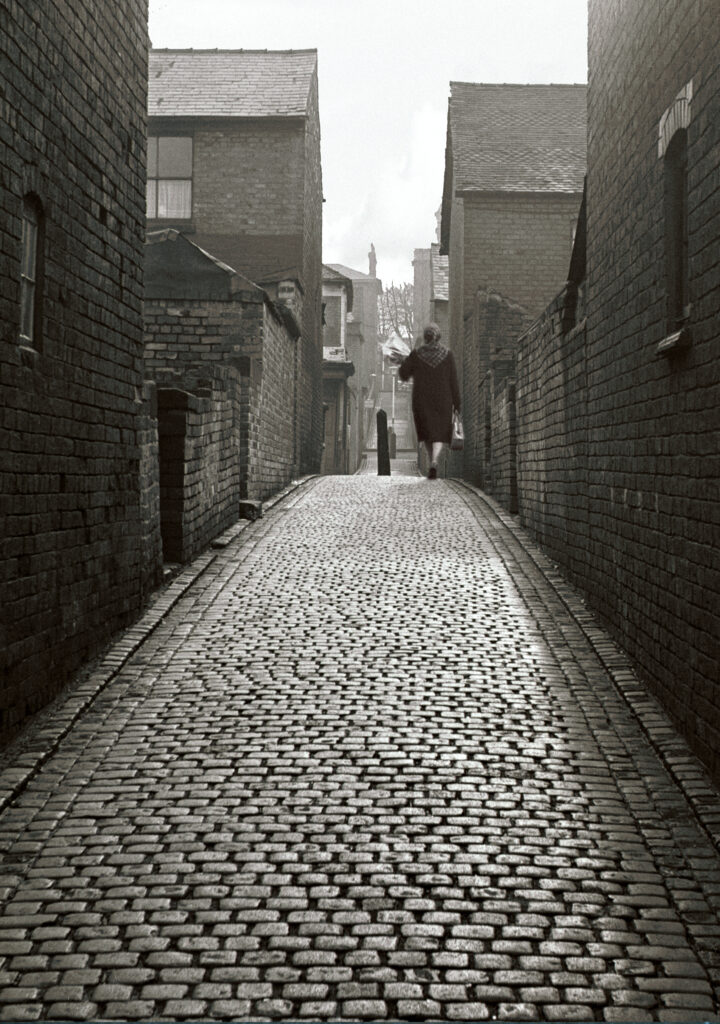
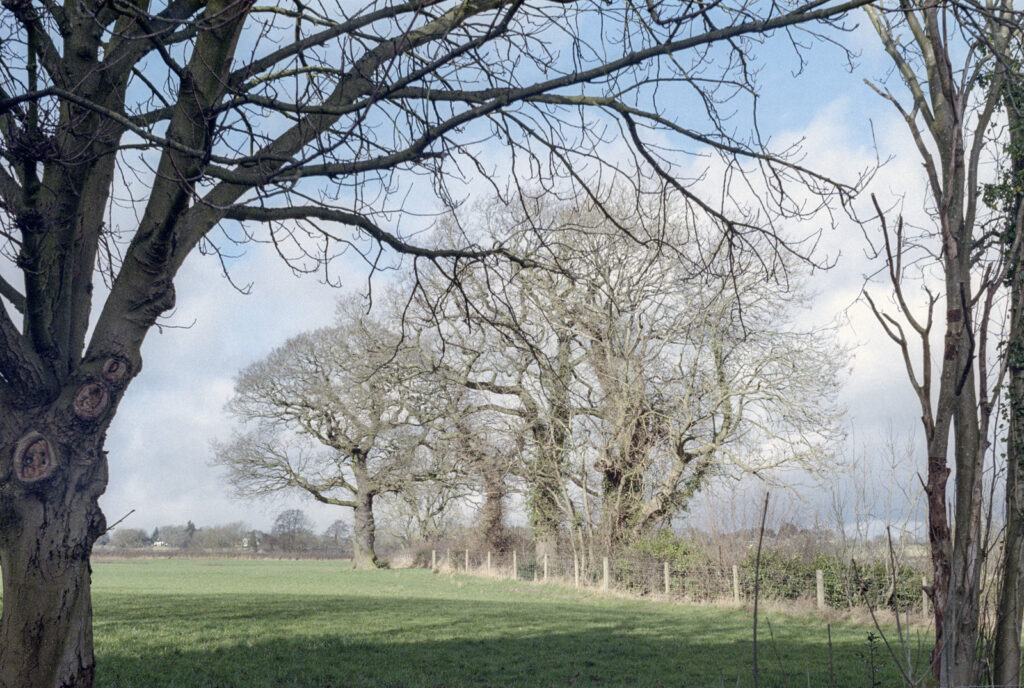
Websites
The origins of the Praktica range is a bit confusing, if you want to know more, then here are some sites you can visit, Mike’s Collection is very comprehensive: praktica-collector.de
Here and here you will find the the Praktica Albums on my Flickr Account
Share this post:
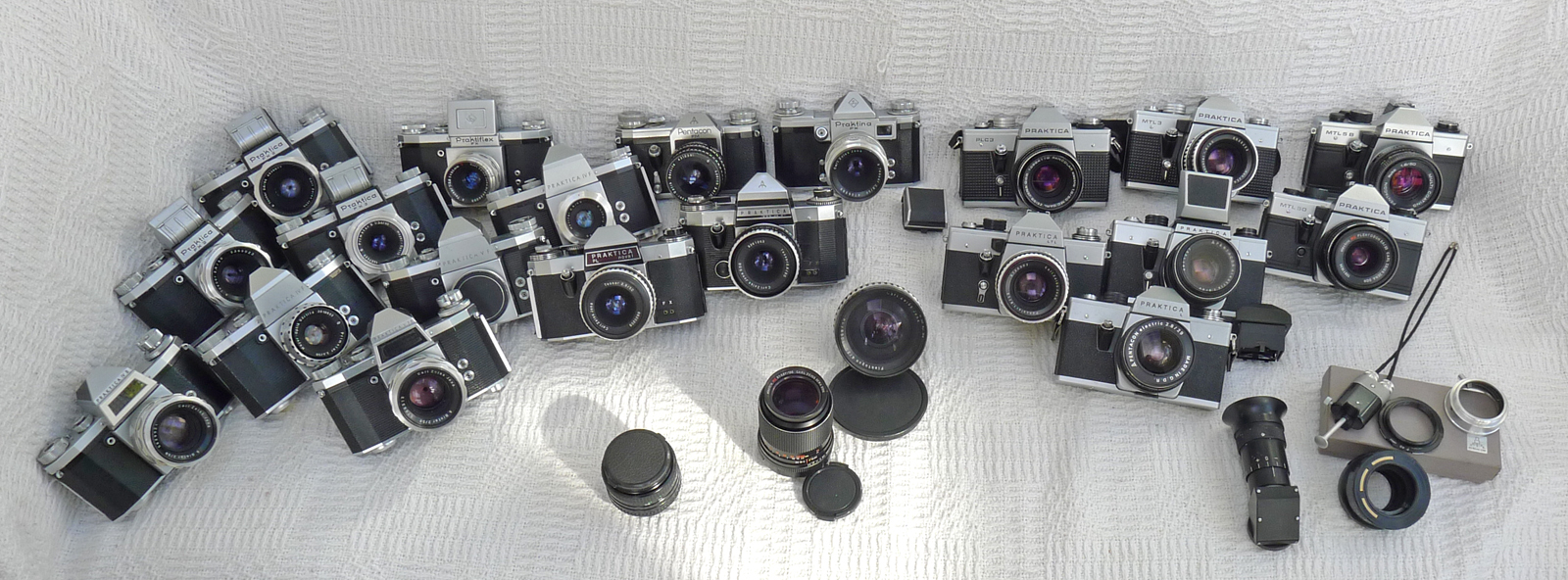
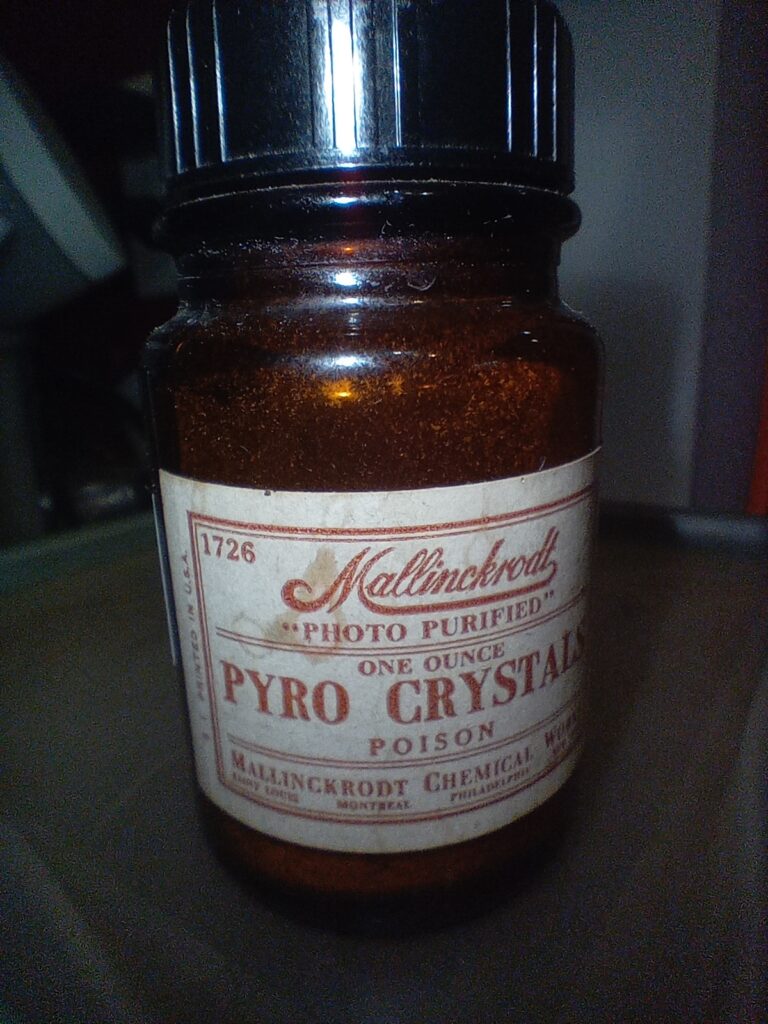
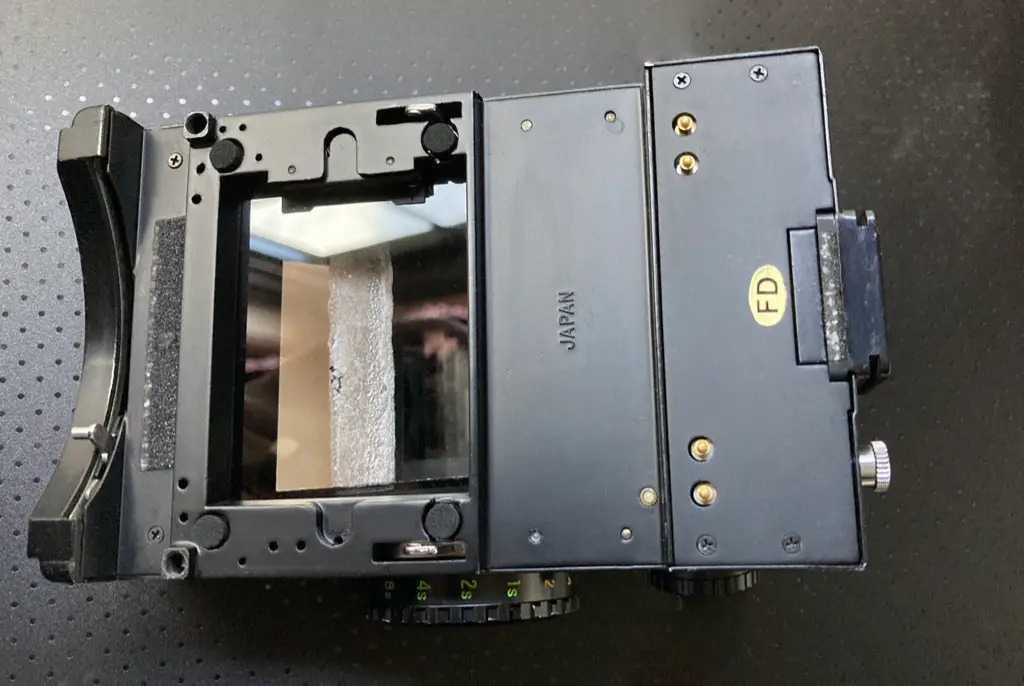
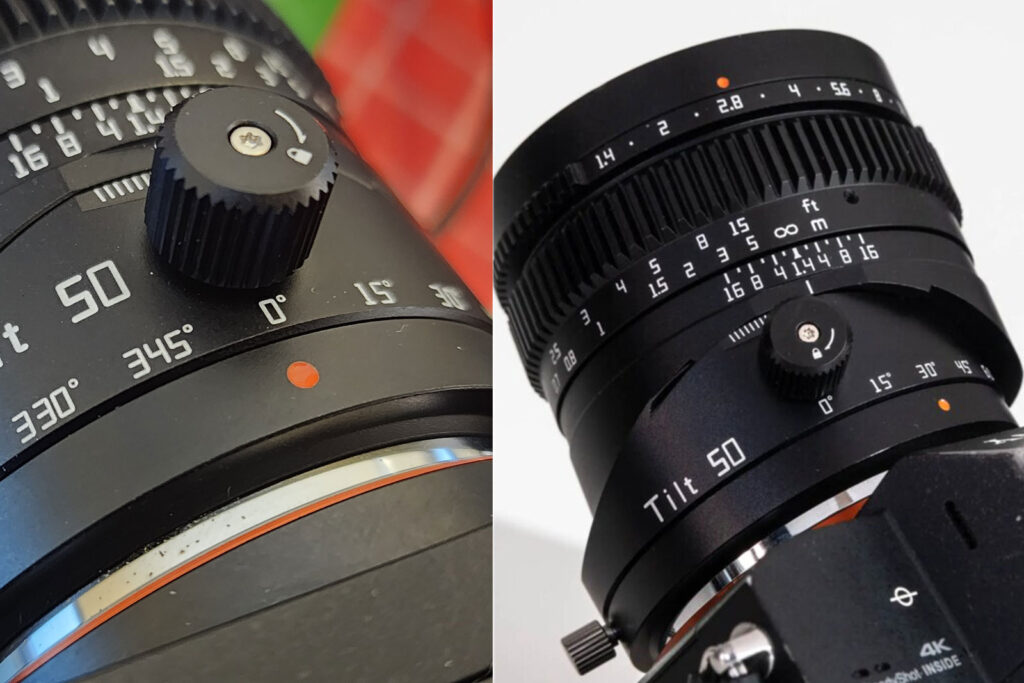
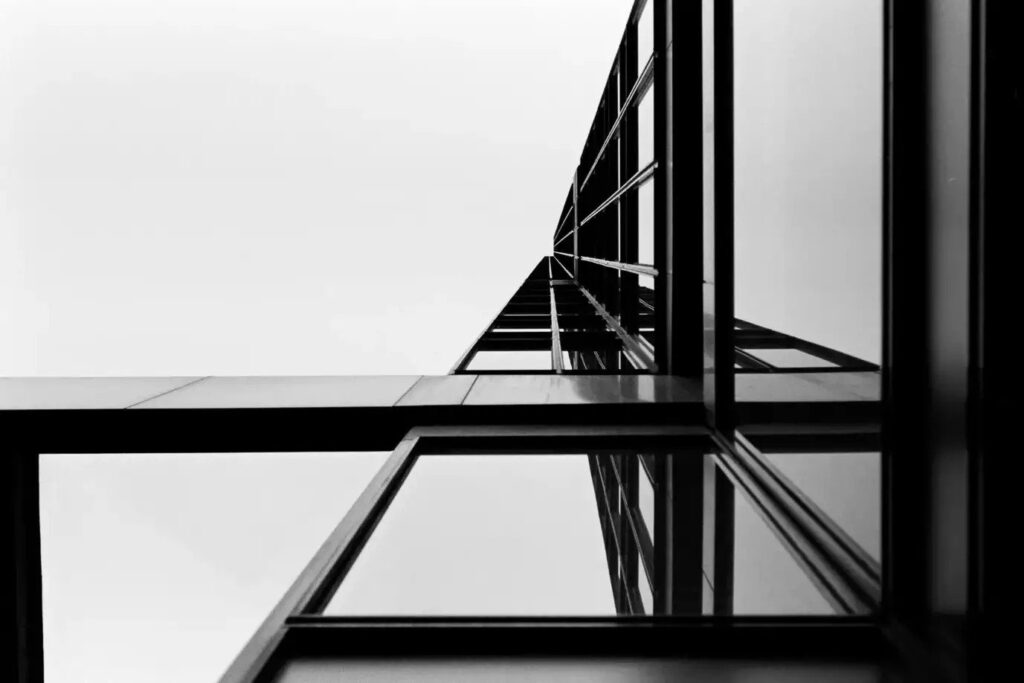
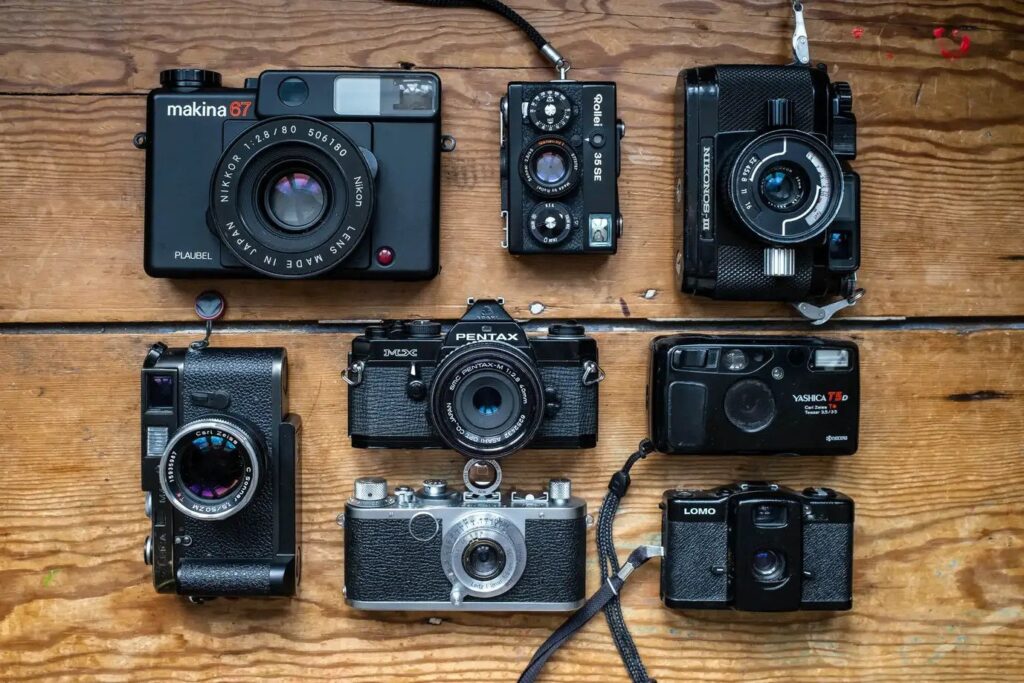
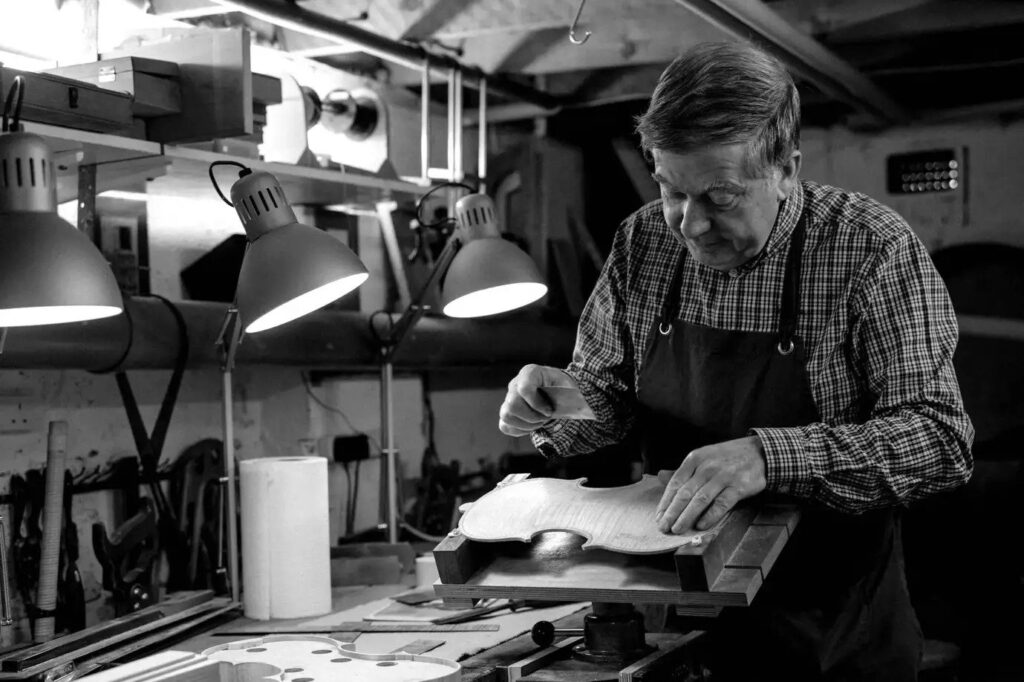
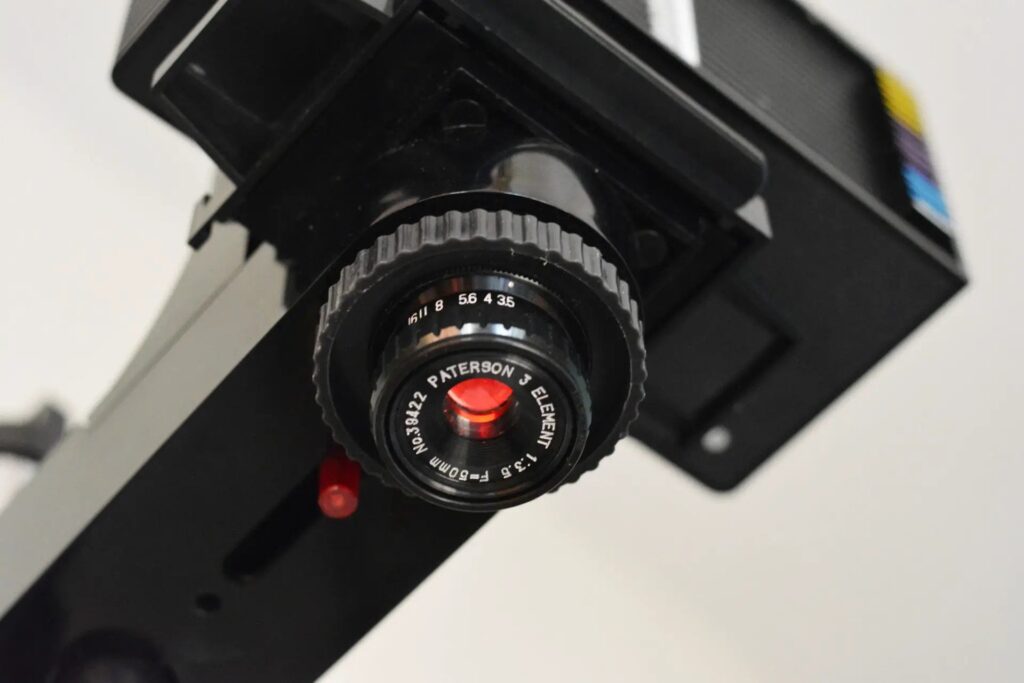
Comments
Andrew on Prakticas and Their Associated Lenses – Building A Film Camera and Lens System At Reasonable Cost
Comment posted: 20/10/2025
I don’t have and Praktica cameras, but I do have a collection of M42 screw lenses which I use on a modern Sony A7 digital and a Canon EOS 200D crop sensor digital..
The absolutely most stunning performer is the Pentax Takumar 28mm f3.5. It is tack sharp across the frame with lovely rendering. A useful wide angle on full frame and a 40mm walk around general purpose on a crop sensor. I can’t recommend it more highly.
The old Yashica Yashinon lenses are also great- my 125mm f2.8 has taken some great photos….
Comment posted: 20/10/2025
Comment posted: 20/10/2025
Ibraar Hussain on Prakticas and Their Associated Lenses – Building A Film Camera and Lens System At Reasonable Cost
Comment posted: 20/10/2025
I’ve stored the page for reference as I want at least one Praktica to use and enjoy
I have a few M42 lenses - my favorites are the Helios and especially the Pentacon 135mm with the zillion aperture blades - that is the only portrait lens I’ve ever needed which I use with my Contax RTS II and A Mount Minolta (first the Dynax 7 and now the 9)
And you’ve presented us with some beautiful photographs
Comment posted: 20/10/2025
Eagle Omomuro on Prakticas and Their Associated Lenses – Building A Film Camera and Lens System At Reasonable Cost
Comment posted: 20/10/2025
Comment posted: 20/10/2025
Matthew Bigwood on Prakticas and Their Associated Lenses – Building A Film Camera and Lens System At Reasonable Cost
Comment posted: 20/10/2025
Comment posted: 20/10/2025
Bob Janes on Prakticas and Their Associated Lenses – Building A Film Camera and Lens System At Reasonable Cost
Comment posted: 20/10/2025
I often see the Pentacon 29 getting flak - My only experience of it was back in 1980 when I was doing a photography O-Level exam in sixth form. The topic we were supposed to produce three photos on was 'The City Awakes' - I got up very early one morning in May 1980 and went up to town, photographing stuff around fleet street and billingsgate. My favourite picture of the set was an outline of the sun rising over the dome of St Paul's - taken with a Pentacon 29 borrowed from the school - I was rather taken with it :-)
Comment posted: 20/10/2025
Comment posted: 20/10/2025
Comment posted: 20/10/2025
Bob Janes on Prakticas and Their Associated Lenses – Building A Film Camera and Lens System At Reasonable Cost
Comment posted: 20/10/2025
Comment posted: 20/10/2025
Nigel Cliff on Prakticas and Their Associated Lenses – Building A Film Camera and Lens System At Reasonable Cost
Comment posted: 20/10/2025
Comment posted: 20/10/2025
Florian on Prakticas and Their Associated Lenses – Building A Film Camera and Lens System At Reasonable Cost
Comment posted: 20/10/2025
I have an LLC with a CZJ Pancolar 50mm 1.8 (late zebra but according to the serial-number list on zeissikonveb.de it should be non-radioactive) which I acquired over the bay for a reasonable price about half a year ago or so (GAS). The meter doesn't work very reliably anymore but other than that the mechanics seem fine. The visual condition of the camera is very good after I had given it a clean up. It is certainly not a Leica as you say more like a reliable workhorse but I like it.
The Pancolar's helicoid still turns easily but needs relubrication. The lens is very sharp and adopts well to modern digital mirrorless cameras. A joy to use.
Comment posted: 20/10/2025
Comment posted: 20/10/2025
Gary Smith on Prakticas and Their Associated Lenses – Building A Film Camera and Lens System At Reasonable Cost
Comment posted: 20/10/2025
Ken Davis on Prakticas and Their Associated Lenses – Building A Film Camera and Lens System At Reasonable Cost
Comment posted: 20/10/2025
Ed Gillam on Prakticas and Their Associated Lenses – Building A Film Camera and Lens System At Reasonable Cost
Comment posted: 21/10/2025
Ken Davis on Prakticas and Their Associated Lenses – Building A Film Camera and Lens System At Reasonable Cost
Comment posted: 21/10/2025
David Pauley on Prakticas and Their Associated Lenses – Building A Film Camera and Lens System At Reasonable Cost
Comment posted: 22/10/2025
Comment posted: 22/10/2025
Omar Tibi on Prakticas and Their Associated Lenses – Building A Film Camera and Lens System At Reasonable Cost
Comment posted: 22/10/2025
Of all the cameras and lenses you've shot, what would you say was your favorite, or at least gave you the most enjoyable experience? From your photos, the Prakticamat caught my eye the most. It looks really beautiful, I'm a sucker for mixing black and chrome, like on my Voskhod. It's also really cool to know that it was an innovative model for its time.
Once again, kudos to your impressive article and equally impressive collection!
Comment posted: 22/10/2025